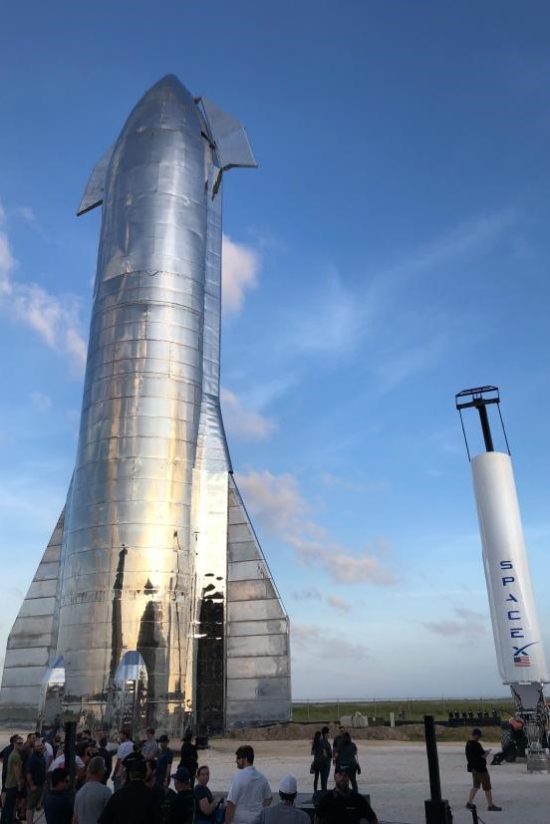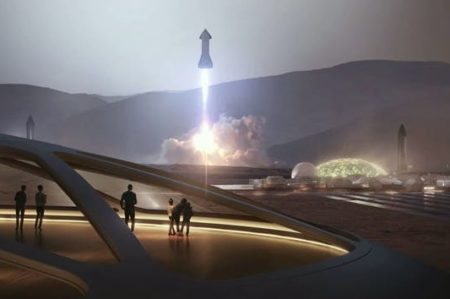September 30, 2019 – We haven’t yet figured out how to balance the demands of our industrial civilization with Earth’s resources, and yet Elon Musk, founder and CEO of SpaceX, has many enthralled about leaving the planet to establish us as an interplanetary species. Whether you believe this is a crackpot notion or not, the meteoric rise of SpaceX over its 11-year existence is proving to be impressive both in accomplishments to-date and in its feeding of the public’s imagination.
On the weekend Musk invited the press to a presentation in Cameron County, Texas, where the company has its space research and development hub, and a likely future spaceport. A Starship prototype designated the Mk1 could be seen behind Musk positioned next to SpaceX’s first successful rocket, the Falcon 1, as the commercial space pioneer reviewed the company’s accomplishments and plans.

Standing 50-meters tall (164 feet), the Mk1 is one of two prototype Starships being built by SpaceX. The second, the Mk2, is being built in parallel at SpaceX’s facility in Cape Canaveral, Florida. The competition between the two SpaceX teams is designed to improve the pace of rapid prototyping and yield design efficiencies learned from both build experiences.
Sometime before the end of this year Musk told the crowd that the Mk1 will fly to a height of 20 kilometers (over 65,000 feet) before returning to its Cameron County base in a soft landing. The Mk2 will also undergo similar flight tests out of the company’s Florida base. One expects further iterations of these test Starships before SpaceX will attempt to launch a Starship into orbit and return it to Earth.
Powering both prototypes is the Raptor engine, a methane-fueled technology developed by SpaceX. The company is building an inventory of these Raptor engines completing one every 8 to 10 days because it intends to build a lot of Starships. Each Mk1 and Mk2 will deploy 3 Raptor engines. The finished Starship will be powered by 6. And the yet-to-be-built Extreme Heavy, the reusable booster rocket to launch Starships to Deep Space will be powered by as many as 37. Every element of these SpaceX rockets will be reusable, a feature that has catapulted the company into becoming a prime launch platform for multiple national space agencies including NASA, and a number of private companies, all attracted to the reduced launch costs associated with this feature.
So how close is SpaceX to its dream of putting spacefarers on the surface of the Moon and Mars?
Musk talks about meeting both objectives in the 2020s on a timetable far more aggressive than that of NASA, ESA, Roscosmos or CNSA, the latter the acronym for China’s space agency. Is there something that these national agencies know that they are not sharing with SpaceX?
The missing ingredient in the Musk equation to get to the Moon and Mars and stay there is the human dimension. How will spacefarers be sulf-sustaining for a prolonged period beyond low-Earth orbit?
The only long-term experience we have in human habitability in space is the International Space Station (ISS) which orbits 408 kilometers (over 250 miles) above the Earth. Technically, ISS hasn’t even left the upper reaches of Earth’s atmosphere. And certainly the ISS is well inside the protection of Earth’s magnetic field, the Van Allen Belt. So the current crew of 9 onboard ISS at present is largely being shielded from the potential lethality of solar and cosmic radiation. Then there is the issue of provisioning ISS with supplies of oxygen, water, food, and replacement parts for onboard things that break. ISS has an umbilical cord of supply ships that regularly bring it life’s necessities. They are just a few hours to a day away.
Musk’s Starship, however, plans to take human travelers well away from that umbilical. A Starships voyage will mean exposure to the extreme environment of space. it will mean self-sufficiency for the duration of voyages to and from the Moon and Mars taking from days to months each way. Starships will need closed-cycle environmental systems that supply the entire needs of the humans on board. And once at the Moon or Mars will need the means to manufacture fuel and oxidizer for a return to Earth in addition to providing life support. Musk on the weekend admitted that lots more work is needed before planting a base on the Moon, and an eventual human colony on Mars. But he is making many of us dream about a reality that he believes will happen far sooner than the timelines presented by the world’s national space agencies.
















